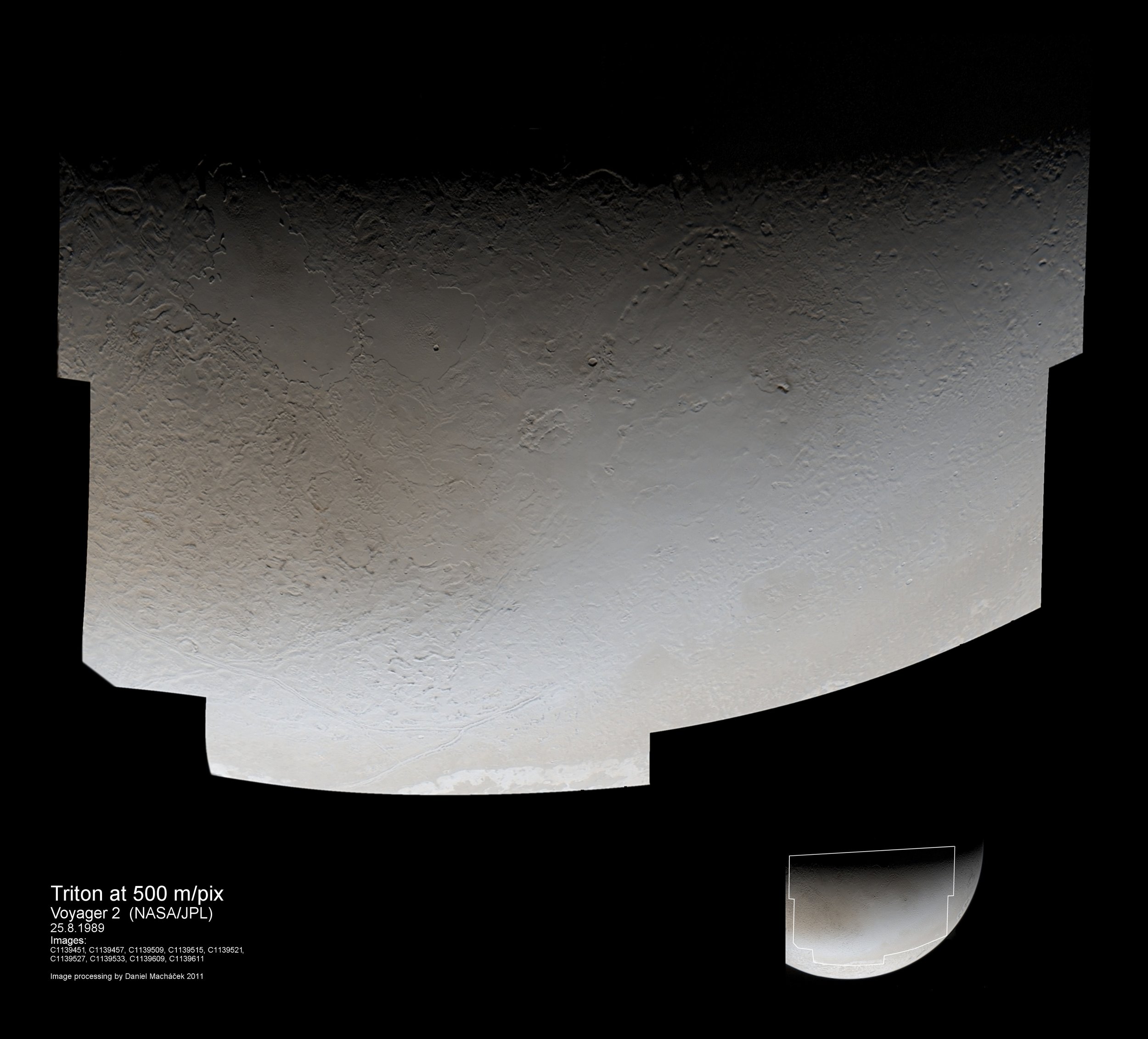New Horizons Can See Pluto and Charon
 There is so little to see here, but to think that New Horizons arrives at this impossibly distant world next year is unreal. Other than some fairly minor bodies, after Pluto and Ceres are visited in 2015 — every major target of interest in the solar system that most of us grew up with will have been visited at least once by robotic spacecraft.
There is so little to see here, but to think that New Horizons arrives at this impossibly distant world next year is unreal. Other than some fairly minor bodies, after Pluto and Ceres are visited in 2015 — every major target of interest in the solar system that most of us grew up with will have been visited at least once by robotic spacecraft.
Crescent Triton
 And you thought the Voyager mission was over. A crescent Triton as seen by Voyager on August 25, 1989. Image by Gordan Ugarkovic.
And you thought the Voyager mission was over. A crescent Triton as seen by Voyager on August 25, 1989. Image by Gordan Ugarkovic.
Two Amazing Images of Comet 67P/CG
 A new imager turning out some impressive work on the Rosetta mission has popped up on flickr. These are not only gorgeous, but are the first color images I have seen of the comet thus far. Check out 2di7 & titanio44’s image feed and see not only more color images of the comet Churyumov-Gerasimenko, but also great work done at Mars and Saturn as well.
A new imager turning out some impressive work on the Rosetta mission has popped up on flickr. These are not only gorgeous, but are the first color images I have seen of the comet thus far. Check out 2di7 & titanio44’s image feed and see not only more color images of the comet Churyumov-Gerasimenko, but also great work done at Mars and Saturn as well.
Image Notes: The original of the first image above can be seen here. What is posted here was cleaned up a bit by wanderingspace.net and is not intended for scientific use. We did the best to represent what is in the original, but telling the difference between what might have been boulders and what was image noise is hard to determine. Also, the jets were reprocessed and altered to appear smooth in this final version. More on the color below.
Image Notes: According to the imagers, there have been no filtered images released as of this date of Comet 67P/CG. Which means that the color above is artistic interpretation. Strikingly real looking, but still just a make-shift approach to consider what the color might be before any real data on color has been released by ESA.
Chop Shop’s Next Kickstarter Project
Honored to have @exploreplanets (#planetarysociety) crowd-source our next @kickstarter campaign. More to come 10/1 pic.twitter.com/MNeuXy00lQ
— wanderingspace.net (@wndrngspc) September 19, 2014
Also worth noting is our new Twitter feed now available twitter.com/wndrngspc.
A Different View
Whoa RT @Astro_Alex: I never imagined that flying to space would give me a different view of our entire galaxy. pic.twitter.com/6mzvOczsR3
— Emily Lakdawalla (@elakdawalla) September 19, 2014
Rosetta Selfie
 With the term “selfie” trending the way it is in popular culture… it was wise for the people at ESA to try a robotic interplanetary version. This image was shot by the Philae lander (still attached to Rosetta) staring down one of Rosetta’s solar panels looking at comet 67P/C-G in not-too-far-off distance.
With the term “selfie” trending the way it is in popular culture… it was wise for the people at ESA to try a robotic interplanetary version. This image was shot by the Philae lander (still attached to Rosetta) staring down one of Rosetta’s solar panels looking at comet 67P/C-G in not-too-far-off distance.
Worth noting this similarly happened here at Mars in 2007.
Discover’s Best of Amateur Imagers
 Discover online has an article today about some of the best in amateur space imaging. Many of which have been featured here on Wanderingspace before like Gordan Ugarkovic, Emily Lakdawalla and Bjorn Jonsson to name a few. The last item from Bill Dunford of Riding With Robots is an image that he actually suggested NASA point their HiRise cameras at that location. He suspected they might find something interesting there and they did —flash water movement and evidence of avalanches.
Discover online has an article today about some of the best in amateur space imaging. Many of which have been featured here on Wanderingspace before like Gordan Ugarkovic, Emily Lakdawalla and Bjorn Jonsson to name a few. The last item from Bill Dunford of Riding With Robots is an image that he actually suggested NASA point their HiRise cameras at that location. He suspected they might find something interesting there and they did —flash water movement and evidence of avalanches.
New Full Disc Images of Neptune
New global mosaic Voyager 2 images of Neptune by Björn Jónsson.
When It’s a Jet, It’s a Jet All the Way
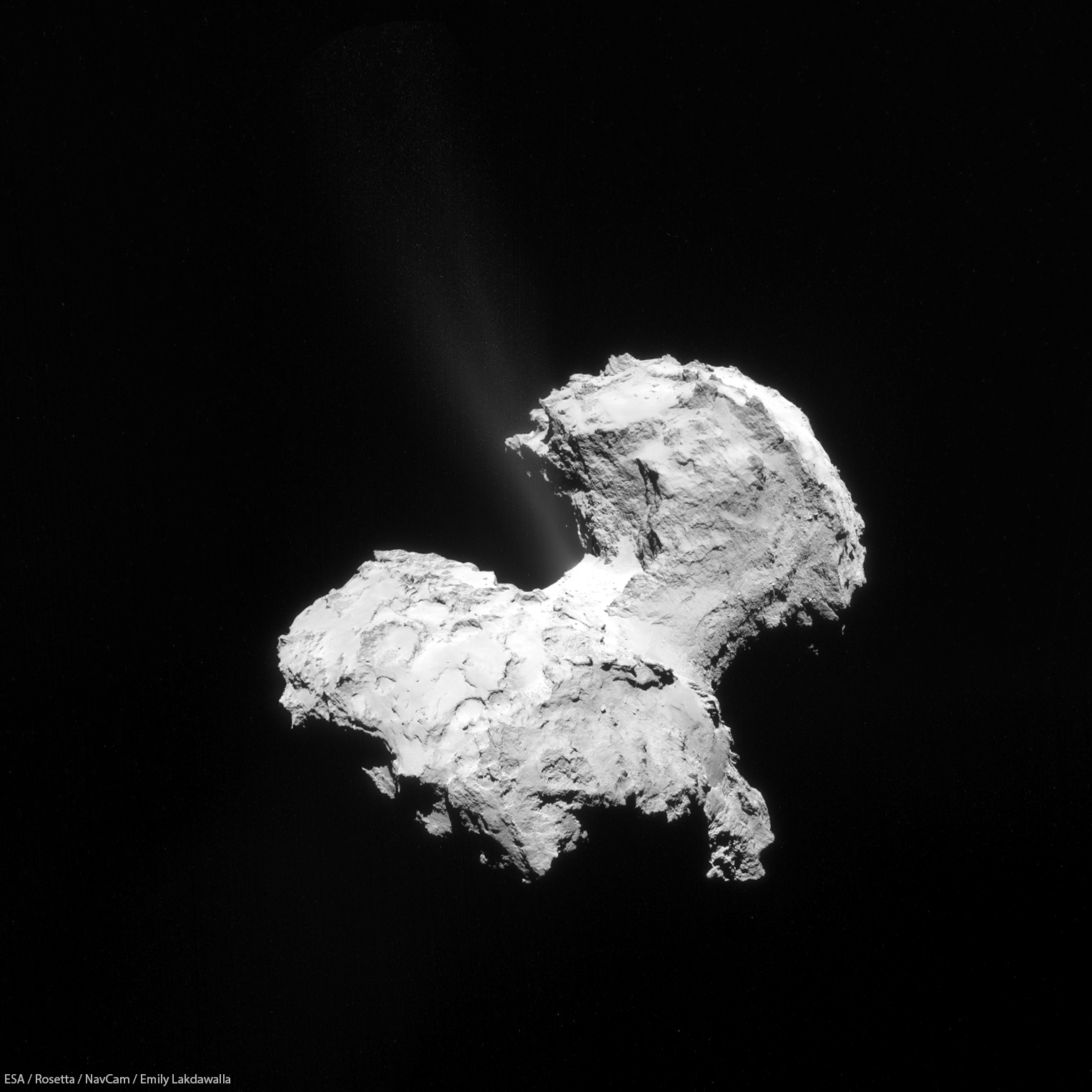 Comet Churyumov-Gerasimenko (aka CG-67P) is showing the early formation of it’s jets. Those jets are what cause the formation of the most distinguishing characteristic of any comet — it’s tail. The Rosetta spacecraft is currently in orbit about the comet and it is assumed that as the pair orbit closer to the sun, these jets will become much more active and should provide quite a show for us. The Rosetta team has also recently shared the potential landing sites for it’s Philae Lander in November shown here.
Comet Churyumov-Gerasimenko (aka CG-67P) is showing the early formation of it’s jets. Those jets are what cause the formation of the most distinguishing characteristic of any comet — it’s tail. The Rosetta spacecraft is currently in orbit about the comet and it is assumed that as the pair orbit closer to the sun, these jets will become much more active and should provide quite a show for us. The Rosetta team has also recently shared the potential landing sites for it’s Philae Lander in November shown here.
This image was brought to the world by Emily Lackdawalla’s Planetary Blog.
Saturnati XXX
 A fine, fine portrait of Saturn for #30! Created by Ian Regan. There is also an amazing “enhanced” version of the same image going around on Twitter.
A fine, fine portrait of Saturn for #30! Created by Ian Regan. There is also an amazing “enhanced” version of the same image going around on Twitter.
Humannaires!
 Mike Mongo (of OBEY fame) is now with Icarus Interstellar whose goal is the first interstellar mission before the year 2100. Please consider crowd-funding Humannaires!, his astronaut instruction manual for pre-teens. It is time for humanity to leave the nest and they just might be the generation to do it!
Mike Mongo (of OBEY fame) is now with Icarus Interstellar whose goal is the first interstellar mission before the year 2100. Please consider crowd-funding Humannaires!, his astronaut instruction manual for pre-teens. It is time for humanity to leave the nest and they just might be the generation to do it!
Triton In Super High-Resolution
Amazing new looks at some pretty old data (Voyager at Neptune in 1989). Thanks to Machi at Unmanned Spaceflight.
Comet 67P/Churyumov-Gerasimenko
 Dramatic view and the highest resolution of the comet so far filling the view. See also this version (if you have 3-D glasses handy).
Dramatic view and the highest resolution of the comet so far filling the view. See also this version (if you have 3-D glasses handy).
Surface of Venus Revealed Again
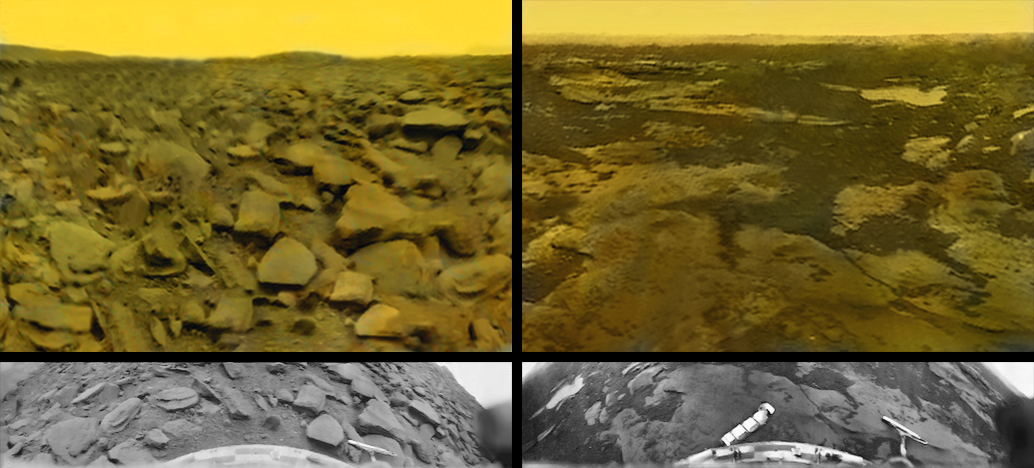 One of the best images to ever grace this blog has to be Don P. Mitchell’s re-renderings of Venera 13 and 14. A miraculous re-rendering of Soviet-era data to create a whole new “human eyes” look at the surface of Venus (I also took the liberty of (artistically) colorizing those images as well). Now Ted Stryk — no stranger to these pages — has taken a shot at Venera 9 and 10 as well. The results are not as amazing as Don’s earlier work but that is simply due the missions having a more limited set of data. I must add that it is pleasing to see Ted’s (a scientist) colorizing is similar to our own (not a scientist).
One of the best images to ever grace this blog has to be Don P. Mitchell’s re-renderings of Venera 13 and 14. A miraculous re-rendering of Soviet-era data to create a whole new “human eyes” look at the surface of Venus (I also took the liberty of (artistically) colorizing those images as well). Now Ted Stryk — no stranger to these pages — has taken a shot at Venera 9 and 10 as well. The results are not as amazing as Don’s earlier work but that is simply due the missions having a more limited set of data. I must add that it is pleasing to see Ted’s (a scientist) colorizing is similar to our own (not a scientist).
See the whole story of how Ted’s images were made here.
Blacker Than Asphalt
 Rosetta has officially arrived at 67P/CG and here is today’s look. These images have apparently been brightened considerably as the comet is supposedly darker than fresh asphalt. It would be good to see what that actually looks like, perhaps something will surface.
Rosetta has officially arrived at 67P/CG and here is today’s look. These images have apparently been brightened considerably as the comet is supposedly darker than fresh asphalt. It would be good to see what that actually looks like, perhaps something will surface.
Image from 130km. Each pixel is about 2.4 meters.
Rosetta At Target Tomorrow
Rosetta Nearing Target 67P (That’s a Comet)
 This mission is just not getting enough public attention. Launched in 2004, the mission has already flown by Mars and two minor asteroids 2867 Šteins in 2008, and of 21 Lutetia in 2010. However, the real target of the mission is coming this week… a comet with the unforgivable name 67P/Churyumov–Gerasimenko. Rosetta will go into orbit around the comet and observe it for the coming months as it nears the Sun which will cause it to start acting more like a comet and forming the familiar tail. As if that were not enough, a small lander named Philae will attempt to land and attach itself to the comet in November.
This mission is just not getting enough public attention. Launched in 2004, the mission has already flown by Mars and two minor asteroids 2867 Šteins in 2008, and of 21 Lutetia in 2010. However, the real target of the mission is coming this week… a comet with the unforgivable name 67P/Churyumov–Gerasimenko. Rosetta will go into orbit around the comet and observe it for the coming months as it nears the Sun which will cause it to start acting more like a comet and forming the familiar tail. As if that were not enough, a small lander named Philae will attempt to land and attach itself to the comet in November.
Enceladus has 101 Geysers
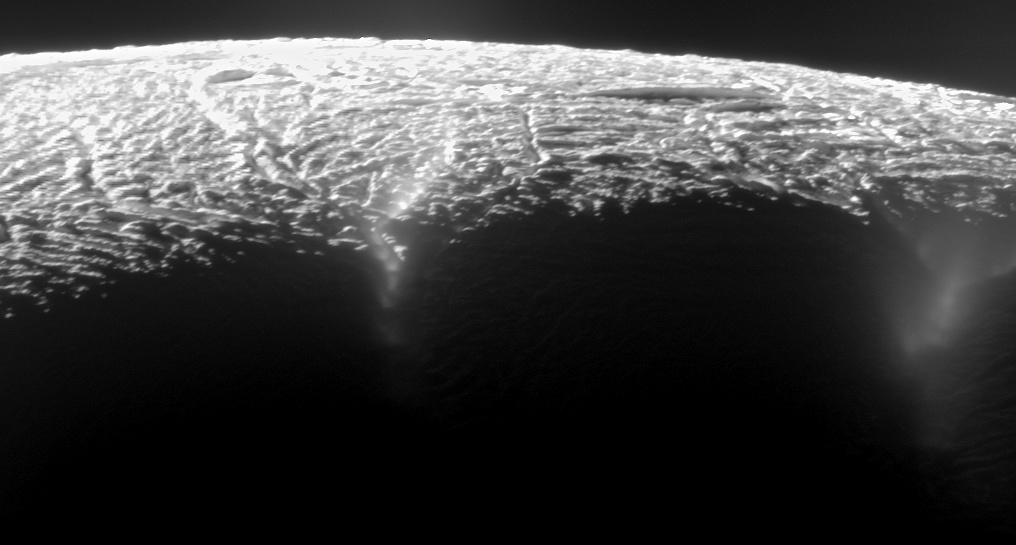 Apparently there are a whole lot of geysers on Enceladus, more than 100. Well only one more, but there are sure to be others. Most of the geysers spotted so far appear along the four noticeably visible “tiger stripes” that appear in the southern hemisphere.
Apparently there are a whole lot of geysers on Enceladus, more than 100. Well only one more, but there are sure to be others. Most of the geysers spotted so far appear along the four noticeably visible “tiger stripes” that appear in the southern hemisphere.
These are two of the most recent images to come from Cassini on this hot region of this medium sized moon. Nice seeing the detail on the geysers in the dark regions of the images where you can actually see where they are originating from on the surface.
Happy Revolution Around the Sun Card
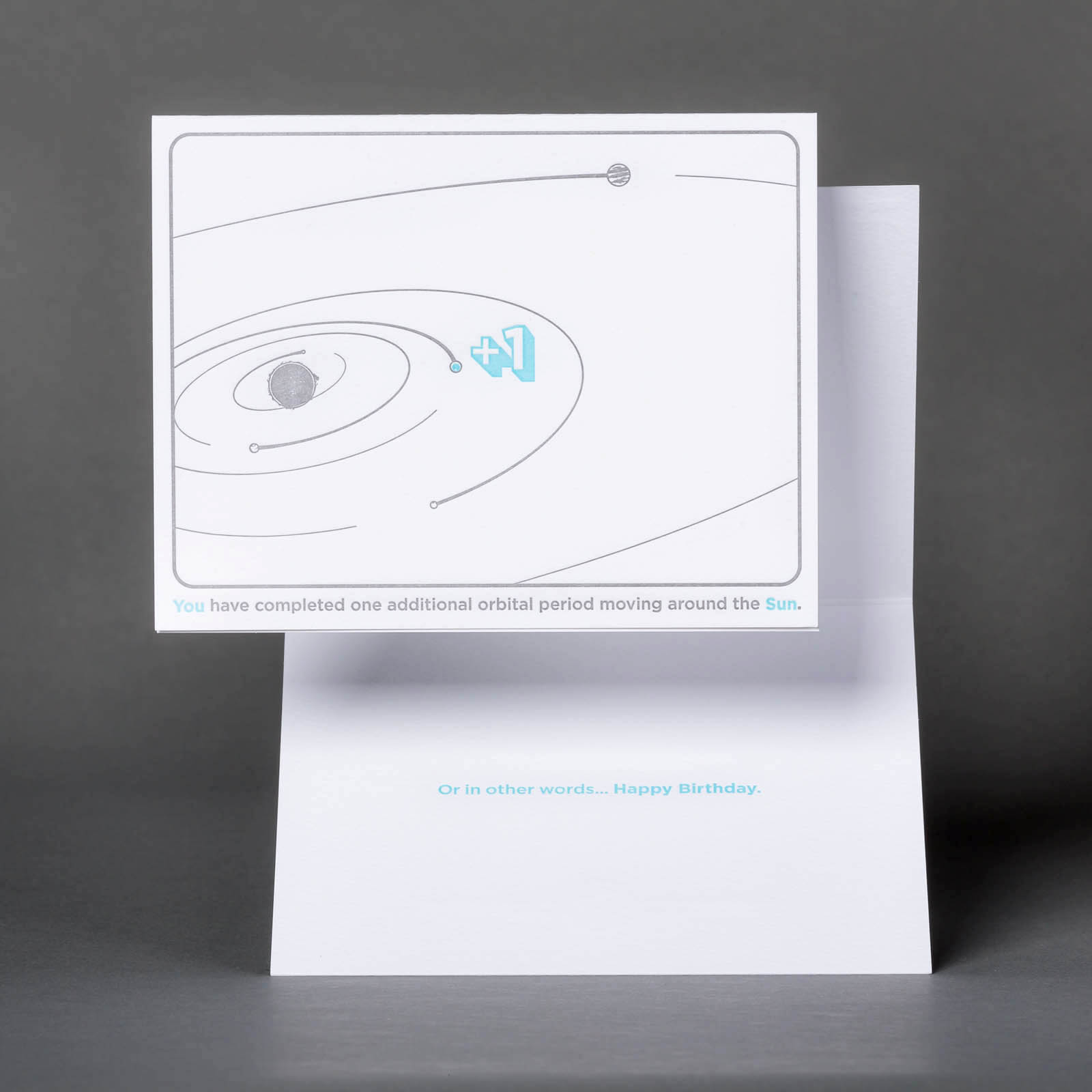 As a fan of space exploration, you will have to love this birthday card from Chop Shop. An overly technical acknowledgment of someone’s birthday by defining exactly what it is. One additional complete orbital period moving around the sun. Even better, they design is beautifully letterpress printed both front and inside.
As a fan of space exploration, you will have to love this birthday card from Chop Shop. An overly technical acknowledgment of someone’s birthday by defining exactly what it is. One additional complete orbital period moving around the sun. Even better, they design is beautifully letterpress printed both front and inside.
Above reveals the inside text — which plays it a little more safe with the messaging.





